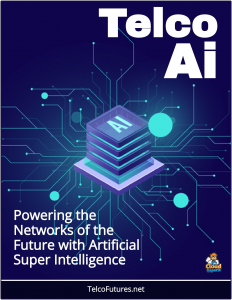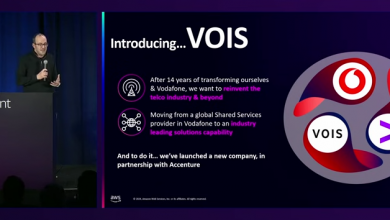 The integration of AI is reshaping the telco industry in profound ways.
The integration of AI is reshaping the telco industry in profound ways.
From optimizing network performance to enhancing customer interactions, AI technologies are revolutionizing how telecommunications companies operate and deliver services.
By embracing AI technologies, telecommunications companies can drive innovation and gain a competitive edge in the market. AI enables telecom providers to automate processes, optimize resource allocation, and deliver personalized services at scale. This transformative technology empowers companies to adapt to changing market dynamics, meet evolving customer demands, and stay ahead of the competition in the digital era.
The Road to Autonomous Networks
AI-powered solutions are enabling telecommunications providers to optimize network performance and efficiency. Through advanced algorithms and machine learning capabilities, AI can analyze vast amounts of data in real-time to predict network congestion, identify potential issues, and proactively address them before they impact service quality.
AI-driven algorithms can analyze vast amounts of network data in real-time, enabling telcos to optimize network performance with unparalleled precision. By leveraging AI-powered analytics, telcos can identify network bottlenecks, predict traffic patterns, and dynamically allocate resources to ensure seamless connectivity for users.
AI plays a crucial role in enabling predictive maintenance and fault detection in telecommunications networks. By analyzing historical data and patterns, AI algorithms can predict potential equipment failures, identify vulnerabilities, and recommend proactive maintenance strategies.
Traditional network maintenance practices often rely on reactive approaches, leading to costly downtime and service disruptions. This proactive approach helps telecom companies minimize downtime, reduce operational costs, and ensure uninterrupted service delivery.
Not all telcos are at the same point on the journey to automation, and challenges still remain. In the feature video George Glass joins Telecom TV to discuss how the TM Forum is helping to overcome these challenges and how they are working with CSPs to accelerate their commercialisation efforts.
Autonomous Network Levels
Autonomous networks represent the future of telecommunications, evolving toward self-managing systems that leverage AI, machine learning, and Network Digital Twins to operate with minimal human intervention.
The TM Forum’s Autonomous Network Levels (ANL) provide a structured framework for this progression, defining six levels (0 to 5) that describe the extent of automation and intelligence in network management. These levels guide operators in assessing their current capabilities and advancing toward fully autonomous operations.
Level 0
Manual Operations marks the starting point, where network management relies entirely on human effort. Engineers manually configure, monitor, and troubleshoot systems using basic tools like command-line interfaces.
This level is labor-intensive, error-prone, and slow, as diagnosing issues or implementing changes requires manual analysis. For example, resolving a network fault involves engineers sifting through logs, leading to delays and inefficiencies. Legacy networks often operate at this level, lacking the agility needed for modern demands.
Level 1
Assisted Operations introduces basic automation for repetitive tasks, such as scripted configurations or automated alerts. While tools like dashboards provide insights to assist operators, human intervention remains essential for decision-making and complex tasks.
For instance, an operator might use automated scripts to restart a network element but still needs to manually investigate root causes. This level reduces some manual effort but does not significantly enhance network intelligence or responsiveness, as automation is limited to predefined tasks.
Level 2
Partial Automation brings more sophisticated automation to specific functions, such as fault detection or performance monitoring, often using rule-based systems. Networks can perform tasks like auto-scaling or basic self-healing within set parameters, but human oversight is still required for validation and cross-domain decisions.
For example, a network might automatically reroute traffic during congestion but need engineer approval for broader changes. By leveraging data analytics, this level enables faster issue resolution, though full autonomy remains out of reach due to reliance on predefined rules.
Level 3
Conditional Automation marks a significant shift, with AI and machine learning enabling predictive and context-aware automation. Networks at this level can autonomously handle specific use cases, such as predictive maintenance or dynamic resource allocation, within defined boundaries. Human involvement is reduced to high-level supervision, such as setting policies or approving critical actions.
A Network Digital Twin at this level might predict a failure using real-time and historical data, automatically adjusting configurations to prevent it while notifying operators for confirmation. This level integrates cross-domain data, improving efficiency and reducing downtime, but autonomy is still constrained by predefined conditions.
Level 4
High Automation achieves near-complete autonomy across multiple domains, with networks operating independently for most tasks. AI-driven systems, often powered by Network Digital Twins, enable real-time decision-making, closed-loop automation, and proactive optimization.
For example, a Level 4 network could autonomously detect a fault, identify its root cause, and implement a fix without human input, while also optimizing energy usage or traffic flow. Operators define high-level intents (e.g., “minimize latency”), and the network translates these into actions. While humans oversee exceptional scenarios or strategic decisions, this level significantly reduces costs and enhances reliability through seamless automation.
Level 5
Full Autonomy is the ultimate goal, where networks are entirely self-managing across all domains, requiring no human intervention. These networks use advanced AI and digital twins to continuously learn, adapt, and optimize in real time, responding to dynamic conditions like traffic surges or outages. They align with business goals, such as maximizing customer satisfaction, without predefined rules.
For instance, a Level 5 network could autonomously redesign its topology to support a new service or recover from a major outage while maintaining service-level agreements. Achieving this level demands robust AI, real-time data integration, and a cultural shift toward trusting autonomous systems.
Conclusion
In conclusion, the TM Forum’s Autonomous Network Levels outline a clear path from manual to fully autonomous network operations. Network Digital Twins play a central role in this evolution, enabling predictive analytics, cross-domain automation, and real-time optimization.
By progressing through these levels, telecom operators can achieve greater efficiency, reliability, and customer satisfaction, transforming networks into intelligent, self-managing systems capable of meeting the demands of a connected world.



